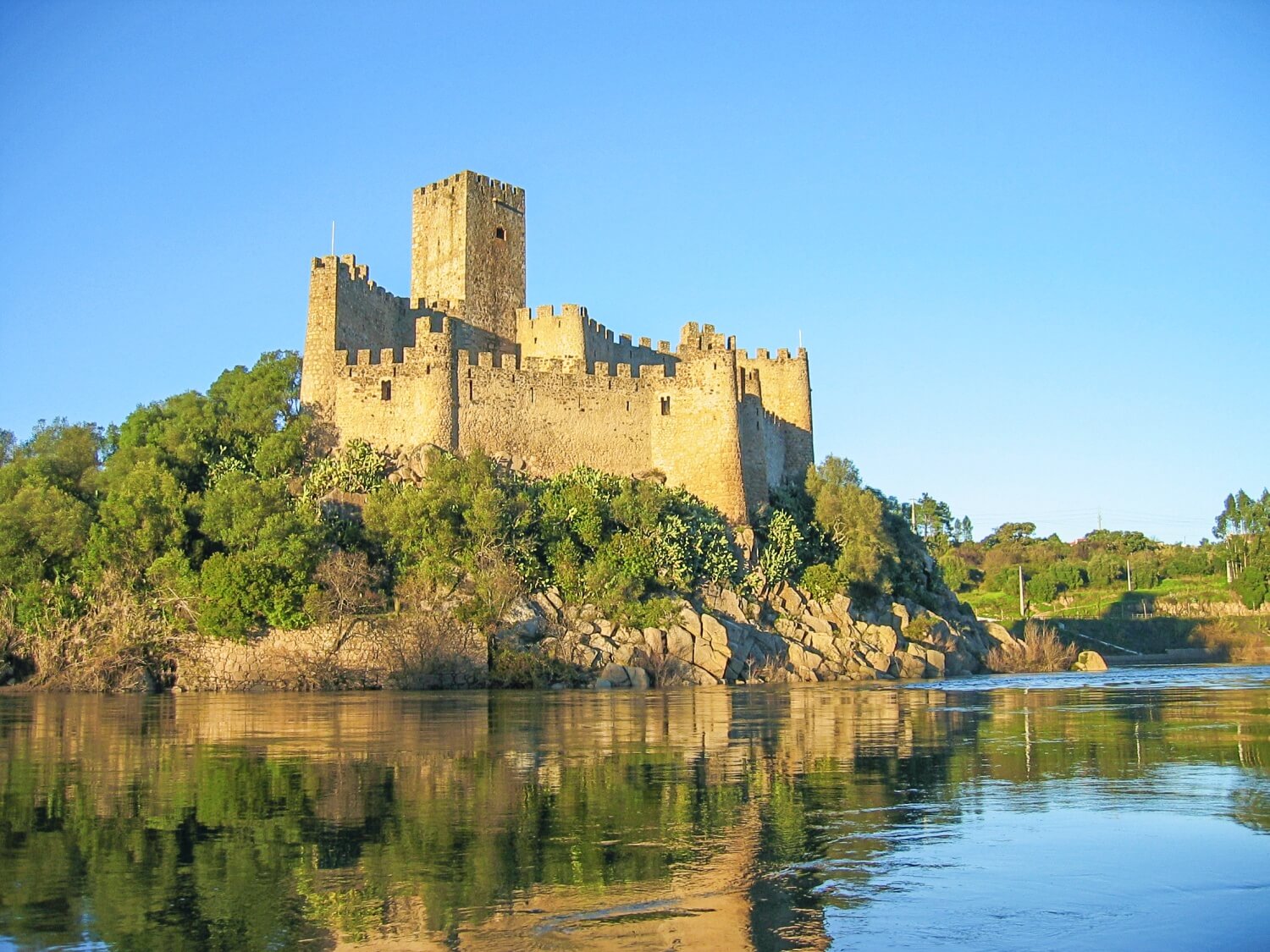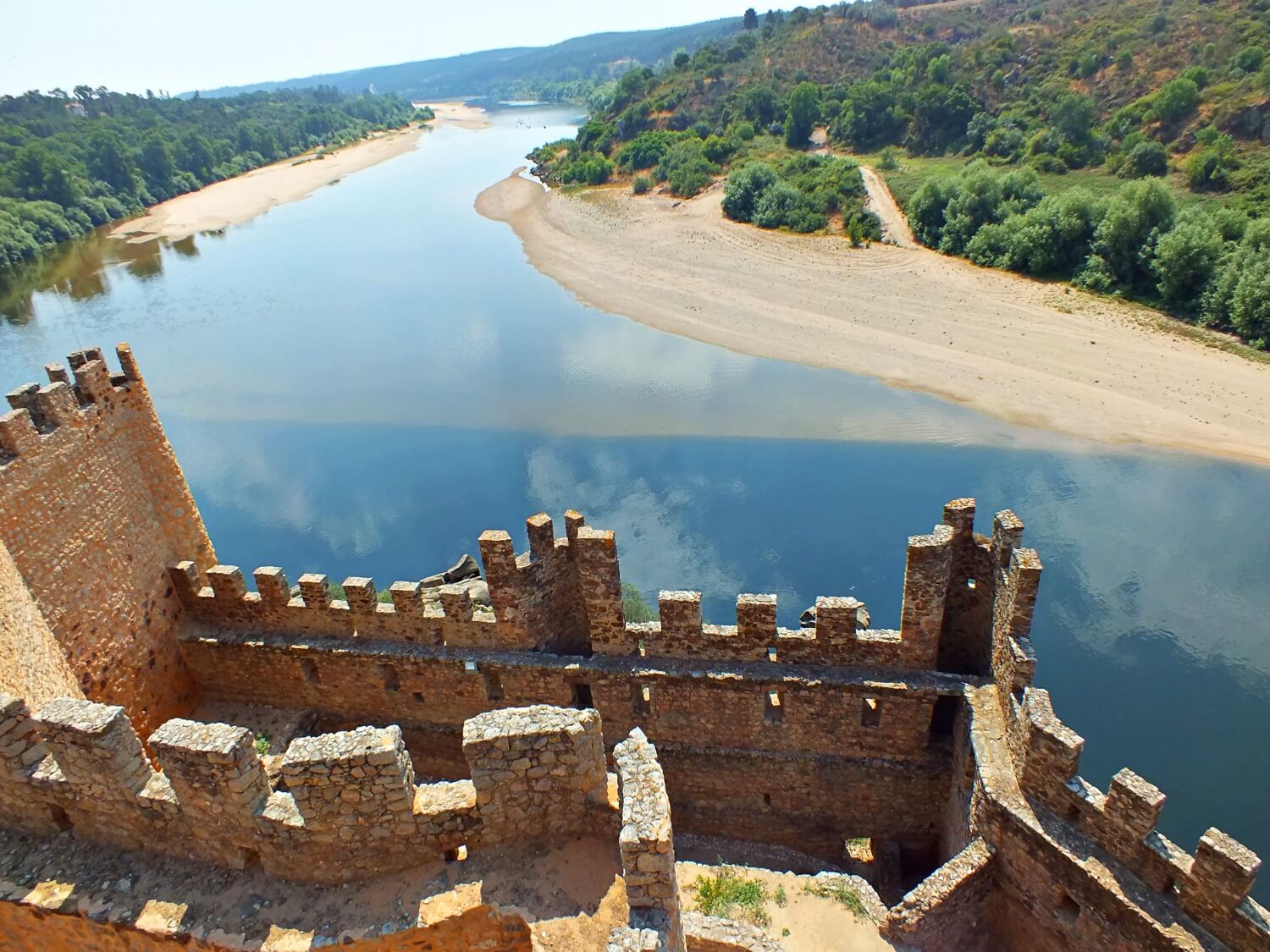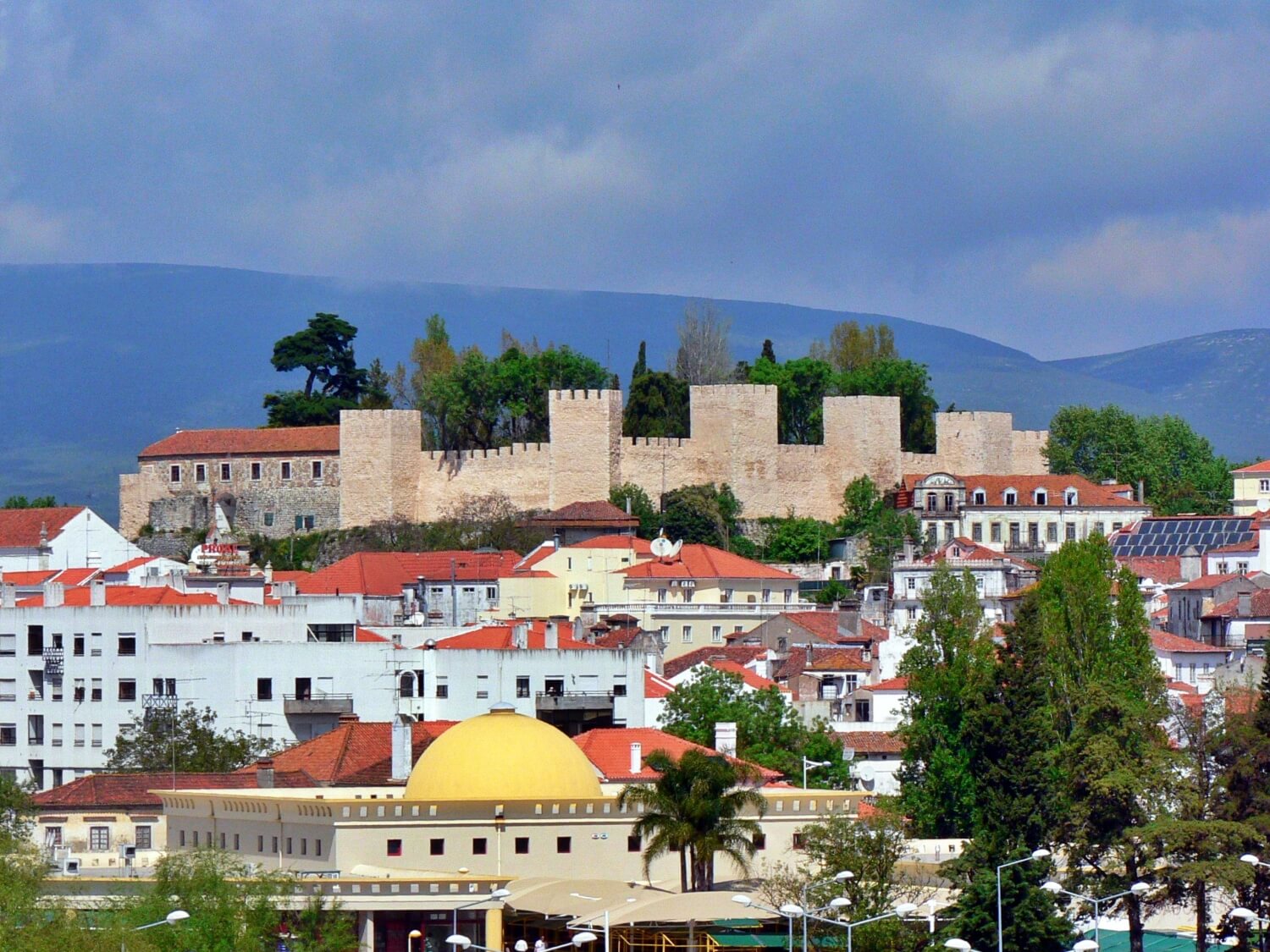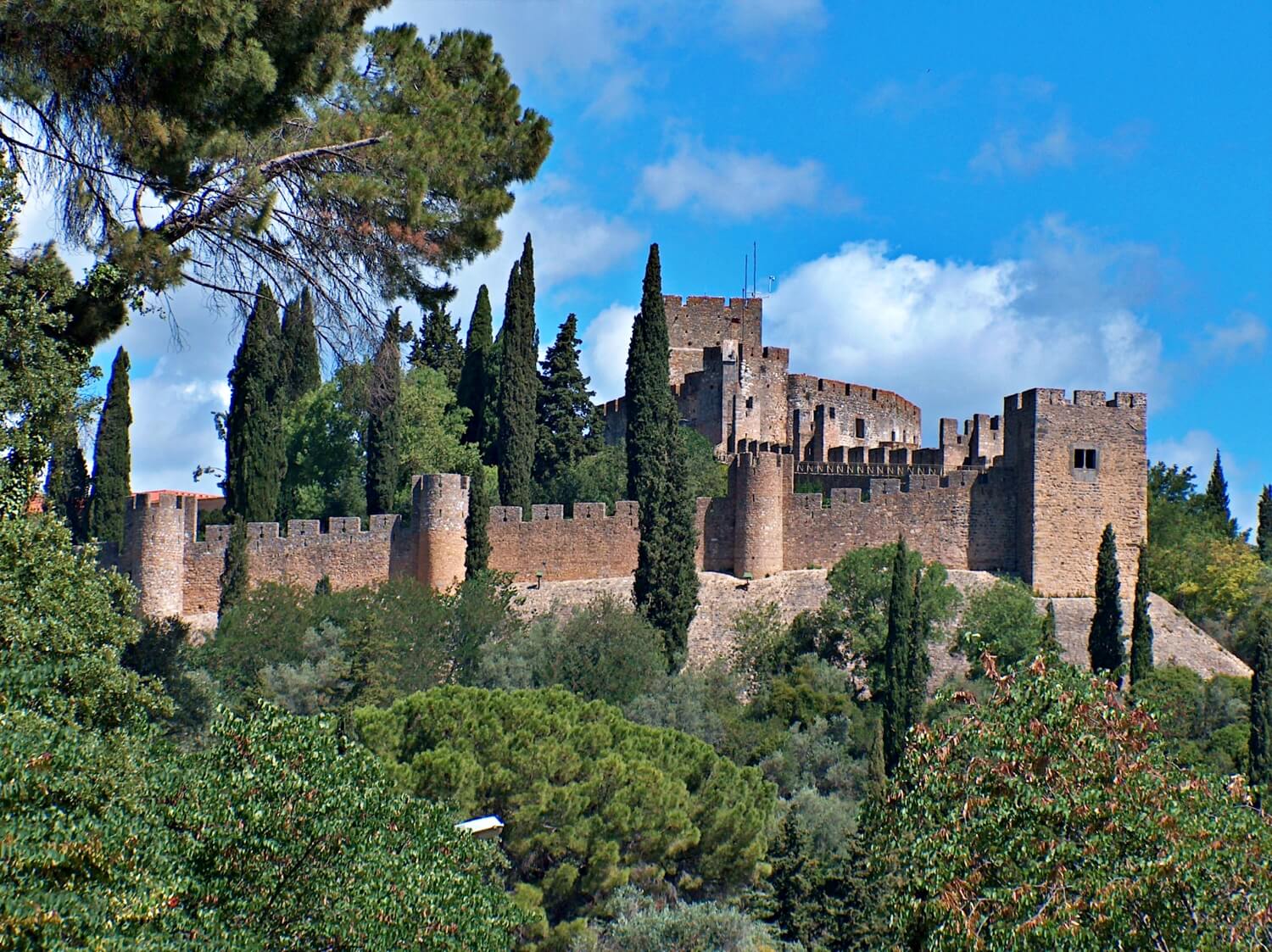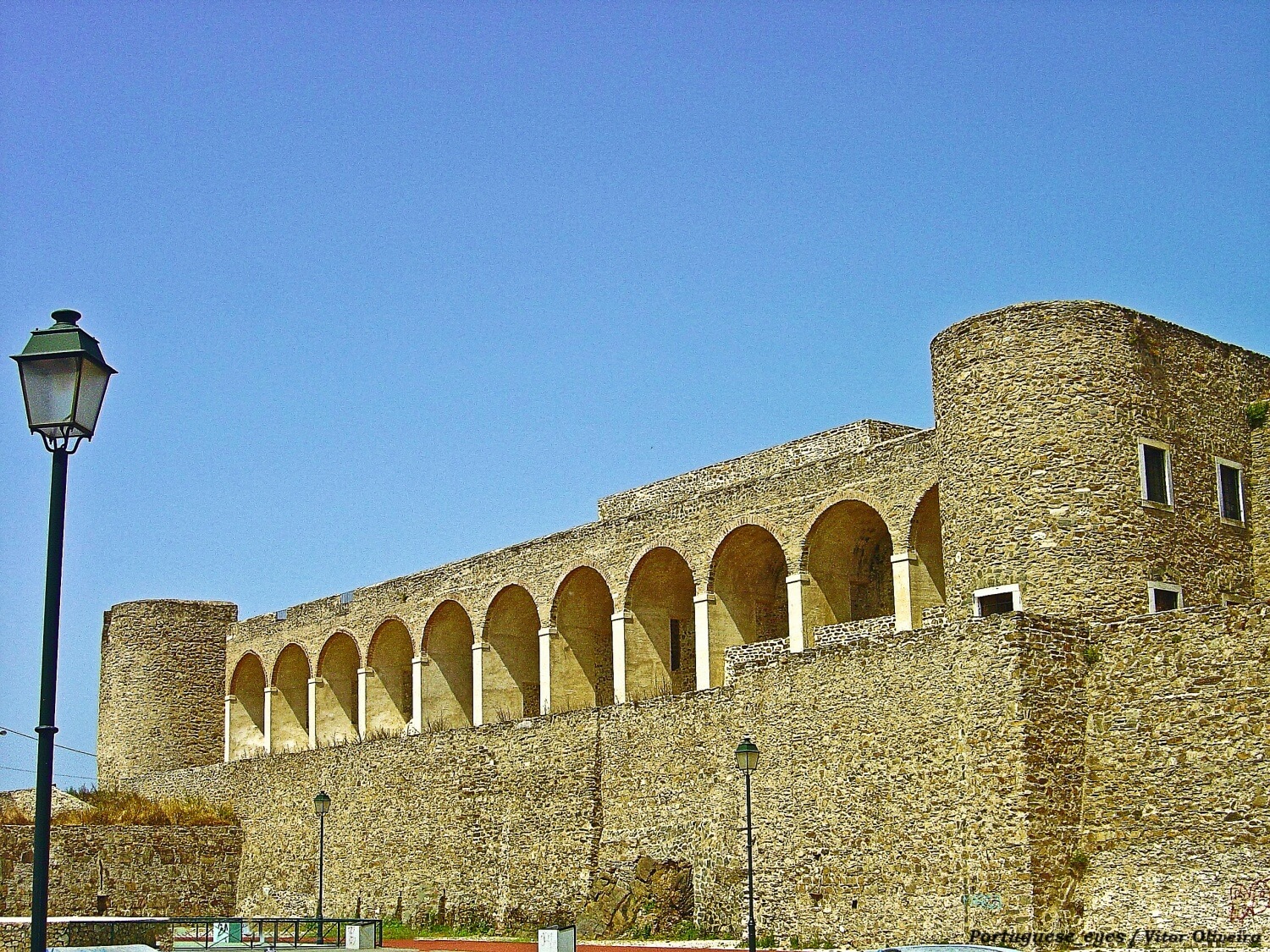Castle of Almourol
Praia do Ribatejo Santarém Portugal
castle, chateau
Castelo de Almourol
Praia do Ribatejo Santarém Portugal
castle, chateau
The Castle of Almourol is a medieval castle atop the islet of Almourol in the middle of the Tagus River, located in the civil parish of Praia do Ribatejo, 4 kilometres (2
O Castelo de Almourol localiza-se na freguesia de Praia do Ribatejo, concelho de Vila Nova da Barquinha, distrito de Santarém, região do Centro (Região das Beiras), em Portugal, embora a sua localização seja frequentemente atribuída a Tancos, visto ser a vila mais perto e onde se vislumbra melhor
Previous names
Castle of Almourol, Castelo de Almourol
Description
The Castle of Almourol is a medieval castle atop the islet of Almourol in the middle of the Tagus River, located in the civil parish of Praia do Ribatejo, 4 kilometres (2.5 mi) from the municipal seat of Vila Nova da Barquinha, in Portugal's Center Region. The castle was part of the defensive line controlled by the Knights Templar, and a stronghold used during the Portuguese Reconquista.
History
It is believed that the castle was constructed on the site of a primitive Lusitanian castro that was later conquered by the Romans during the 1st century B.C.E. It was later remodeled by successive invading forces, including the Alans, Visigoths and the Andalusian Berbers, although it is unclear when the actual castle was established. In excavations carried out in the interior and exterior enclosures, various vestiges of Roman occupation were discovered including coins, millennium markers, and Roman foundations, while medieval remnants such as medallions and two marble columns were also discovered in the castle's vicinity.
The castle of Almourol is one of the more emblematic and cenographic medieval military monuments of the Reconquista, and one of the best representations of the influence of the Knights Templar in Portugal. When it was conquered in 1129 by forces loyal to the Portuguese nobility, it was known as Almorolan, and placed in the trust of Gualdim Pais, the master of the Knights Templar in Portugal, who subsequently rebuilt the structure. The structure was reconstructed, starting in 1171 (from an inscription over the principal gate) and restored during the subsequent reigns.
Losing its strategic place, it was abandoned, resulting in its fall into ruins. In the 19th century, it was "reinvented" by idealistic romanticists, which eventually led to interventions in the 1940s and 1950s, and its adaption as an Official Residence of the Portuguese Republic. During this period, there were many restorations that transformed the physical appearance of the structure, including the addition of crenellations and bartizans.
The DGMEN - Direcção-Geral dos Edifícios e Monumentos Nacionais (Directorate-General of Buildings and National Monuments), the forerunner of the IGESPAR, first intervened on the site in 1939, through the construction of the chemin de ronde in masonry, including reinforced concrete; the dismantlement and reconstruction of the corner of the keep; repair and consolidation of the battlements, including the demolition of the tower's allure, reconstruction of a brick vault under the existing; and reconstruction of the pavement in small stone.
Around 1940-1950, the spaces were adapted for its use as an official residence of the Portuguese Republic. At the end of this short term, the building's furniture was acquired by the Commission for Furniture Acquisition (Portuguese: Comissão para a Aquisição de Mobiliário) in 1955, while an electrical system was installed.
Between 1958 and 1959, there was some consolidation of the keep with concrete straps, a project to diminish the permeability of the courtyard and reconstruction of the interior walls of the tower by the Escola Prática de Engenharia (Practical School of Engineering), as well as the reconstruction of a door that included doorposts and lintels. In subsequent years, other projects followed: in 1959, the façade of one section of wall was repaired; in 1960, with the conclusion of the repairs to the exterior walls, the pavement and road access was improved by the Direcção da Arma de Engenharia de Tancos (Tancos Directorate for the Engineering Arm). However, one roadway that skirted the islet from the quay to the southern end of the castle was reconstructed by the Serviços de Engenharia do Estado Maior do Exército (Army General Staff Engineering Services).
By 1996, the walls had been repaired, sections of the keep were preserved, and the pavement in the castle restored.
21st century and tourism
Owing to water infiltration, the castle began to show some signs of degradation by 2004, including a few of the exterior walls.
Although access to the Portuguese National Monument and fluvial islet is free, visitors to the structure must pay for an inexpensive boat-ride across the river, the only way for visitors to reach the castle.
Architecture
The castle rises over a granite outcropping 18 metres (59 ft) in height, and is approximately 310 metres (1,020 ft) long and 75 metres (246 ft) wide, in the middle of the Tagus River waterway, a few metres below its confluence with the Zêzere River in front of the town of Tancos.
The castle has an irregular rectangular plan consisting of two enclosures: an exterior lower level faces upstream with a traitors' gate and walls reinforced by nine tall circular towers; while the interior enclosure, located at a higher elevation, has walls accessible by the main gate to the main keep. The keep is three stories tall, and includes the original pads that supported the main truss. The remaining sentry towers are irregular, owing to the irregular terrain. The keep is actually an innovation at this castle, appearing in the 12th century after the Castle of Tomar, the principal defensive redoubt of the Templars in Portugal. Similarly, the watchtowers were innovations brought into the western Iberian peninsula by the Templars, and applied in Almourol.
The interior is bisected by several masonry doorways that link the different parts of the castle. Two inscription stones mark the castle's history and its re-edification by Gualdim Pais (over the main gate), as well as its Christian history (from the cross carved into the space above an open window in the keep).
O Castelo de Almourol localiza-se na freguesia de Praia do Ribatejo, concelho de Vila Nova da Barquinha, distrito de Santarém, região do Centro (Região das Beiras), em Portugal, embora a sua localização seja frequentemente atribuída a Tancos, visto ser a vila mais perto e onde se vislumbra melhor.
Erguido num afloramento de granito a 18 metros acima do nível das águas, numa pequena ilha de 310 metros de comprimento por 75 metros de largura, no médio curso do rio Tejo, um pouco abaixo da sua confluência com o rio Zêzere, à época da Reconquista integrava a chamada Linha do Tejo, atual Região de Turismo dos Templários. Constitui um dos exemplos mais representativos da arquitetura militar da época, evocando simultaneamente os primórdios do reino de Portugal e a Ordem dos Templários, associação que lhe reforça a aura de mistério e romantismo.
Com a extinção da Ordem do Templo o castelo de Almourol passa a integrar o património da Ordem de Cristo (que foi a sucessora em Portugal da Ordem dos Templários).
História
Antecedentes e toponímia
Embora os autores não sejam unânimes acerca da primitiva ocupação humana deste sítio, acreditando-se que remonte um castro pré-histórico, a pesquisa arqueológica trouxe à luz testemunhos do período romano (moedas do século I a.C.) e do período medieval (medalhas). Alguns autores, ainda, identificam em alguns trechos na base das muralhas, exemplos do aparelho construtivo de tipo romano.
A partir do século III, o sítio foi ocupado por outros grupos, nomeadamente os Alanos, os Visigodos e os Muçulmanos, estes últimos a partir do século VIII. No século XIII, a fortificação já existia, por eles denominada como Al-morolan (pedra alta).
Não se pode precisar a origem do seu nome, assim como se torna difícil clarificar o significado e a própria grafia do qual são conhecidas variações: Almoriol, Almorol, Almourel, Almuriel. Outros autores estabelecem ligação com o termo Moron, que Estrabão teria referido como cidade situada à beira Tejo, ou com o termo Muriella, que consta da descrição da delimitação do Bispado de Egitânia e Corretânea.
O castelo medieval
À época da Reconquista cristã da Península Ibérica, quando esta região foi ocupada por forças portuguesas, Almourol foi conquistado em 1129 por D. Afonso Henriques (1112-1185). O soberano entregou-o aos cavaleiros da Ordem dos Templários, então encarregados do povoamento do território entre o rio Mondego e o Tejo, e da defesa da então capital de Portugal, Coimbra.
Nesta fase, o castelo foi reedificado, tendo adquirido, em linhas gerais, as suas atuais feições, características da arquitetura templária: espaços de planta quadrangular, muralhas elevadas, reforçadas por torres adossadas, Tinham 9 torres e uma mais alta e na janela virada a nascente tem uma cruz dos Templários. Dominadas por uma torre de menagem. Uma placa epigráfica, colocada sobre o portão principal, dá conta que as suas obras foram concluídas em 1171, dois anos após a conclusão do Castelo de Tomar, edificado por determinação de Gualdim Pais, filho de Paio Ramires. As mesmas características arquitetónicas estão presentes também no Castelo de Idanha, no de Monsanto, no de Pombal, no de Tomar e no de Zêzere, seus contemporâneos.
Sob os cuidados da Ordem, constituído em sede de uma Comenda, o castelo tornou-se um ponto nevrálgico da zona do Tejo, controlando o comércio de azeite, trigo, carne de porco, frutas e madeira entre as diferentes regiões do território e Lisboa. Acredita-se ainda que teria existido uma povoação associada ao castelo, em uma ou em ambas as margens do rio, uma vez que, em 1170, foi concedido foral aos seus moradores.
Com o avanço da reconquista para o sul e a extinção da Ordem dos Templários em 1311 pelo papa Clemente V durante o reinado de D. Dinis (1279-1325), a estrutura passou para a Ordem de Cristo, vindo posteriormente a perder importância, tendo sofrido diversas alterações.
Do século XVIII aos nossos dias
Vítima do terramoto de 1755, a estrutura foi danificada, vindo a sofrer mais alterações durante o romantismo do século XIX. Nessa fase, e obedecendo à filosofia então corrente de valorizar as obras do passado à luz de uma visão ideal poética, o castelo foi alvo de adulterações de índole decorativa, incluindo o coroamento uniforme das muralhas por ameias e merlões.
O castelo foi entregue ao Exército português na segunda metade do século XIX, sob a responsabilidade do comandante da Escola Prática de Engenharia de Tancos, a que está afeto até aos nossos dias.
No século XX foi classificado como Monumento Nacional de Portugal por Decreto de 16 de Junho de 1910. À época do Estado Novo português o conjunto foi adaptado para Residência Oficial da República Portuguesa, aqui tendo lugar alguns importantes eventos oficiais. Para esse fim, novas intervenções foram promovidas nas décadas de 1940 e de 1950, reforçando aspetos de uma ideologia de nacionalidade cultivada pelo regime à época.
No início de Junho de 2006 foram inaugurados dois novos cais para embarcações turísticas: um na margem direita do rio Tejo e outro na zona Sul da ilha.
Em setembro de 2013, iniciaram-se os trabalhos de beneficiação das muralhas e intervenção na torre de menagem do Castelo de Almourol para criar um espaço museológico.
As obras, que se prolongarão por seis meses e implicam um investimento na ordem dos 500 mil euros, incidirão em diversas zonas de desagregação dos panos da muralha e das torres, com a sua impermeabilização, drenagem das águas e beneficiação das muralhas.
A intervenção na torre de menagem incidirá na substituição do atual terraço, na colocação de uma escada metálica de circulação vertical e na instalação de um sistema expositivo de conteúdos referentes aos Templários, visando preservar e proteger o monumento e possibilitando-lhe melhores condições de acessibilidade e circulação.
Atualmente é possível visitar o Castelo de Almourol e realizar passeios no rio Tejo, acrescentando valor e interesse as visitas do Monumento. Desde Tancos, Arripiado e Vila Nova da Barquinha.
Useful information
Free
Free
- Great view
- Information tables
Ruins of the castle
-
Nearby castles
